We had a very hard freeze this past winter, and it took its toll in the garden, killing some plants back to the ground, and seriously nipping others. Spring clean-up is long past, but for some reason (maybe it’s the uncompromised-by-cold thorns on its branches!) we never got around to cutting back the partly-killed bougainvillea that clings to the back porch latilla, despite the disorderly brown leaves and gray stem.
Now it’s too late! This little charmer, a first-year male Costa’s Hummingbird, is holding the withered vine and nearby nectar feeder as his own, and I don’t have the heart to prune his perch. Gaze upon his Adolescentness — he’s just growing in his soon-to-be-glorious purple Yosemite Sam moustachios! He’s fairly fearless, and sat on a twig singing just feet from me, as I was taking macro shots of a poor sun-spider I’d fished moribund out of the pool. When I say “singing” I mean emitting a high, thin “sssseeeee” and spraying the sound all around by holding his bill slightly upward, while moving his head gently back and forth like an electric fan. It’s hardly audible to human ears, but clearly does the trick for the species, as he was recently an egg himself.
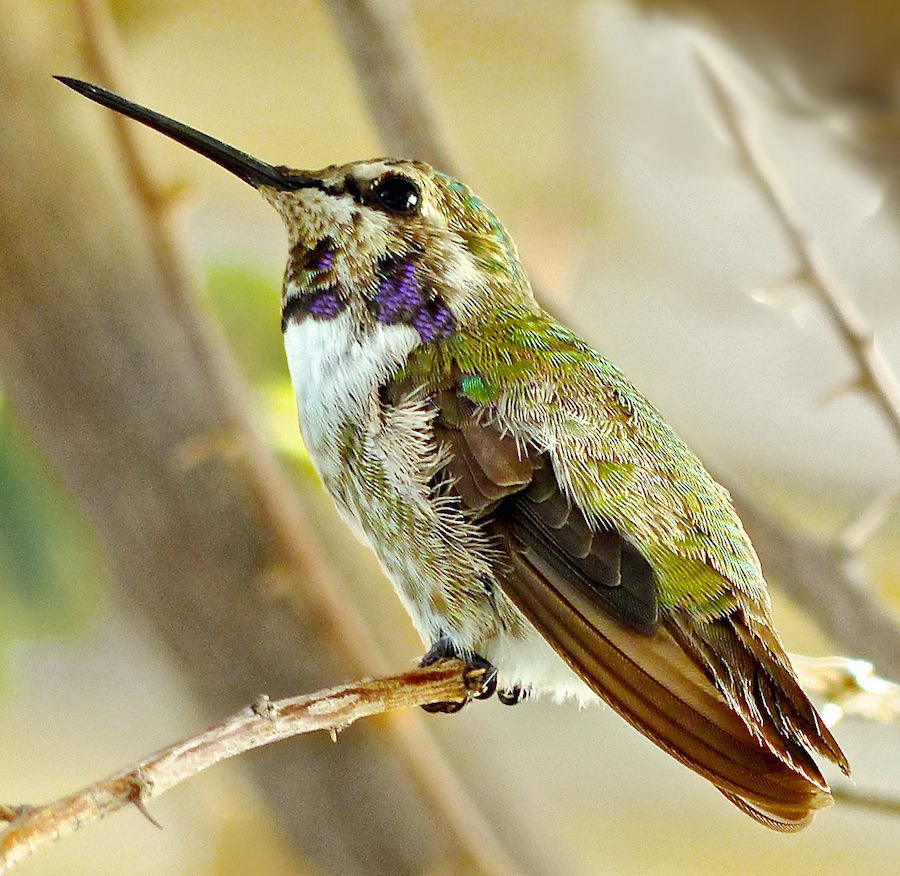
First-year male Costa’s Hummingbird (Photo A.Shock)
 In anticipation of a major and photogenic meteorological event, I went out just now to photograph the storm. With the exception of some dramatic skies, the whole mess skipped over us (we need the rain, but I can’t say I miss dust and wind). But I caught something else brooding and unpredictable. It shouldn’t be hard for you to spot it, its eye is partly open. Horizontal napping bark.* (See HNB the first here.) Once you’ve found it, click to enlarge, I’ve uploaded a generous-sized file.
In anticipation of a major and photogenic meteorological event, I went out just now to photograph the storm. With the exception of some dramatic skies, the whole mess skipped over us (we need the rain, but I can’t say I miss dust and wind). But I caught something else brooding and unpredictable. It shouldn’t be hard for you to spot it, its eye is partly open. Horizontal napping bark.* (See HNB the first here.) Once you’ve found it, click to enlarge, I’ve uploaded a generous-sized file.
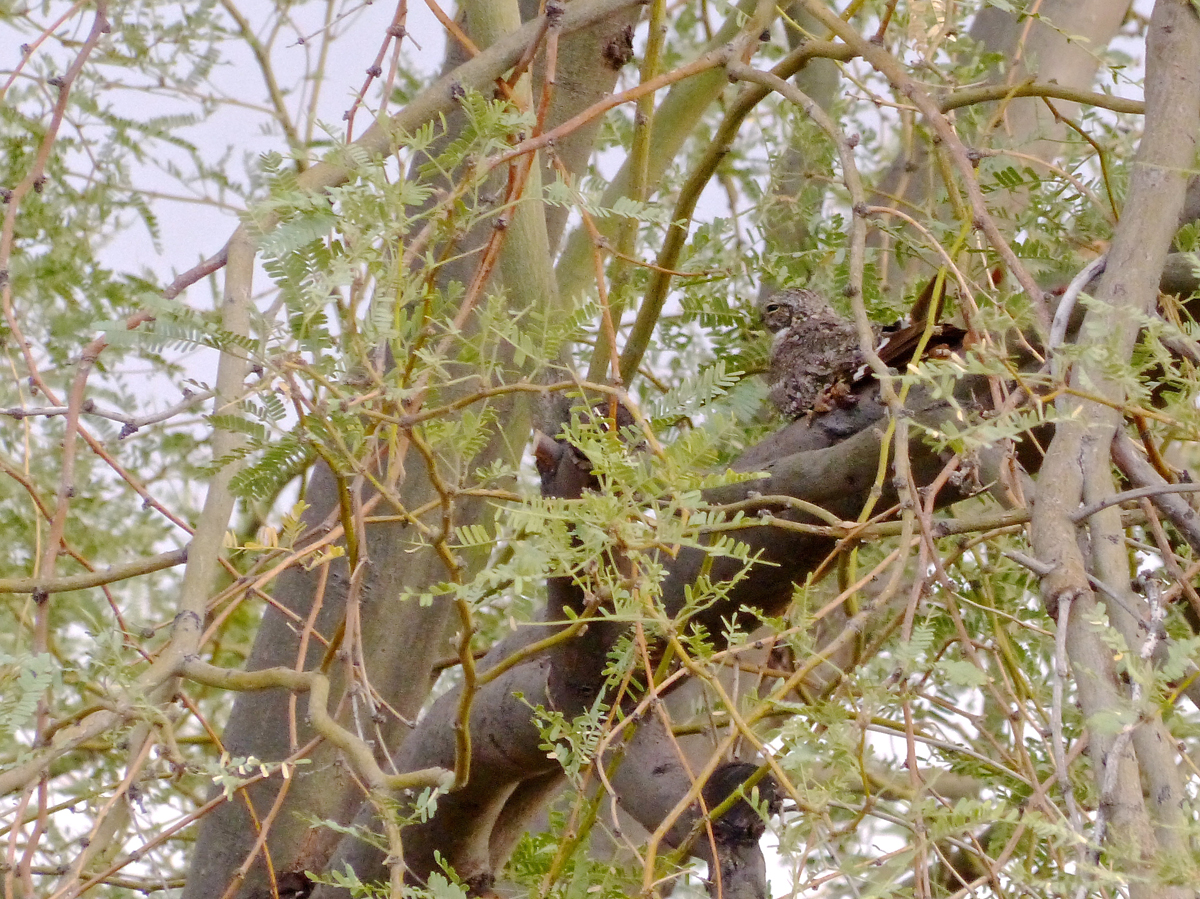 For readers unfamiliar with the group of birds called nightjars, this is a Lesser Nighthawk (Chordeiles acutipennis, a member of the caprimulgid family or goat-suckers, along with Whippoorwills and kin). It’s hunkered parallel to a mesquite branch with its tail pointed at the camera. The bird flew up off the ground as I was watching the sky, did a lap of the neighbor’s yard, and settled on a branch where it will stay until it’s dark enough to launch on an aerial forage. Even though the bird is facing slightly away from the camera and behind some twigs, you can see the distinctive white throat patch, and the white mark on the primaries neatly folded over its tail. This is one of a pair of birds who nested on the gravel of a neighbor’s front yard. In an effort to keep wildlife out, the homeowner created a stir along the block (it’s not a very pretty fence) and also a really good habitat for ground-nesting birds. I look at the unpopular fence a little differently, knowing that a pair of nighthawks has fledged nestlings inside its confines for each of the last three years, at least. (Photo A.Shock)
For readers unfamiliar with the group of birds called nightjars, this is a Lesser Nighthawk (Chordeiles acutipennis, a member of the caprimulgid family or goat-suckers, along with Whippoorwills and kin). It’s hunkered parallel to a mesquite branch with its tail pointed at the camera. The bird flew up off the ground as I was watching the sky, did a lap of the neighbor’s yard, and settled on a branch where it will stay until it’s dark enough to launch on an aerial forage. Even though the bird is facing slightly away from the camera and behind some twigs, you can see the distinctive white throat patch, and the white mark on the primaries neatly folded over its tail. This is one of a pair of birds who nested on the gravel of a neighbor’s front yard. In an effort to keep wildlife out, the homeowner created a stir along the block (it’s not a very pretty fence) and also a really good habitat for ground-nesting birds. I look at the unpopular fence a little differently, knowing that a pair of nighthawks has fledged nestlings inside its confines for each of the last three years, at least. (Photo A.Shock)
*Vertical napping bark would be, of course, an owl. This concept inaugurated the Spot the Bird feature here on Three Star Owl blog.
Here’s a photo of a bird in a tree, in black and white:
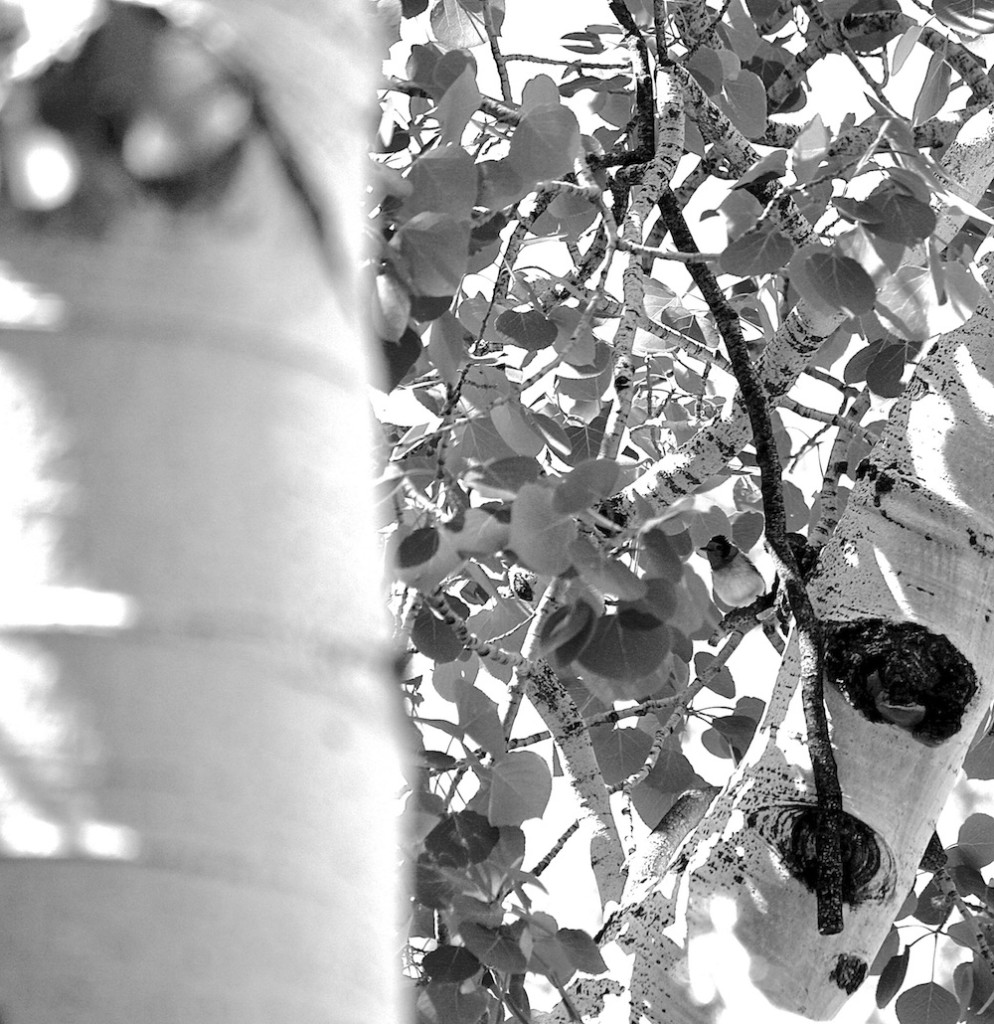
With a little bit of searching, you’ll find the tiny bird, made less obvious by its dark-and-light values breaking up its birdy outline. This helps it blend well with the aspen leaves and bark. It also helps it to be invisible to any predator with weak color vision, such as nocturnal birds.
Evading hungry owls searching for songbirds on night roosts is a good thing, but during the day this male Red-faced Warbler (Cardellina rubrifrons) needs to be able to advertise his presence, so that rival boys 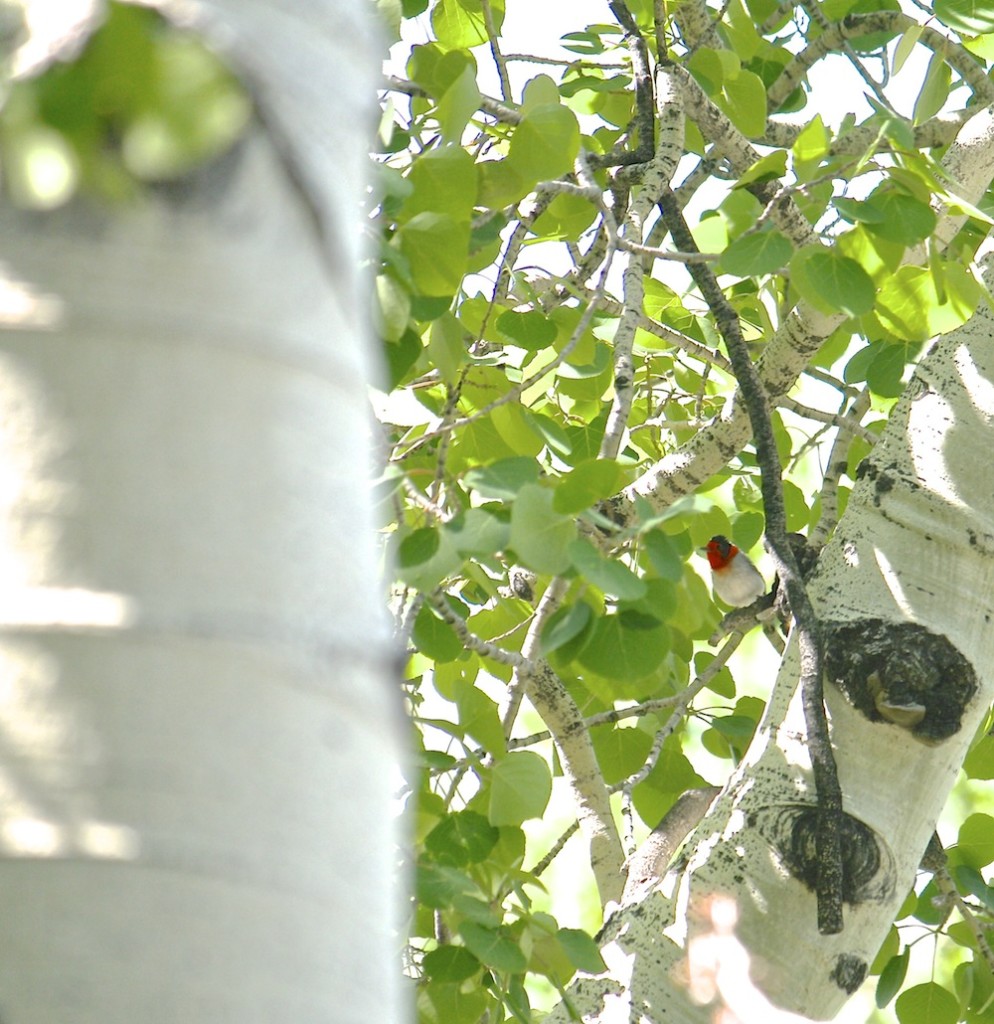 beware and girls know he’s there. His song does this, but so does his high-contrast red and black face.
beware and girls know he’s there. His song does this, but so does his high-contrast red and black face.
Fortunately, most songbirds’ eyes are well supplied with color receptors, so what they (and we mammals) see is this >>
(Photo A.Shock, June 2013, Veit Springs, Lamar Haines Memorial Wildlife Area, San Francisco Peaks, AZ. Click either version to enlarge)
Together with his song and active, flitting movement through the trees, his bright colors make this tiny organism a known presence to anyone walking, flying, or trotting through high-altitude mixed deciduous/coniferous forests of Arizona, New Mexico, and Mexico. It’s a risky gambit: while we were at the Springs, an immature accipiter (most likely a Cooper’s hawk) flew through — a bird-eating predator whose retinas are well-supplied with color-sensing cones.
For a close-up image of a Red-faced Warbler and a recording of its peppy song, click here.
The young peachy person shown below has been hanging out in our Old Scottsdale yard, eating seed-fluffs off of Creosote bushes. It’s a Rosy-faced Lovebird (Agapornis roseicollis, formerly known as the Peach-faced lovebird) with naturally-occurring variant plumage called “Lutino”. The image inset bottom left shows a bird with the standard “wild” coloration, also photo’d in our yard.
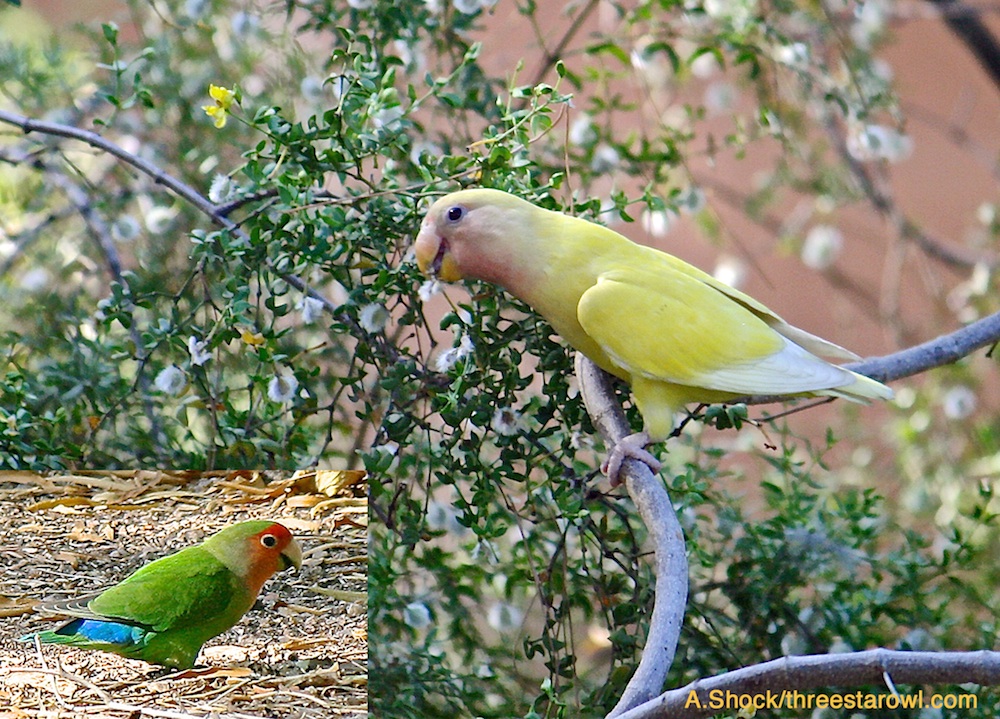
Rosy-faced Lovebirds have been naturalizing themselves in the greater Phoenix area since the mid-1980s, and are probably the descendants of escaped pets. For the full story, read Kurt Radamaker and Troy Corman’s excellent account on the Arizona Field Ornithologists website.
This lemony youngster flies with two “normal”-plumaged individuals, presumably its parents. Although it doesn’t show in this photo, the bird has a few reddish feathers coming in above its beak, the first indication that it will soon sport a coral forehead. Breeders offer this azureless color variant under the name “Lutino”, but the fact that this bird is a youngster suggests that it hatched ferally, and is not an escaped pet.
Update: with a bit of further research, I turned up some info on Lovebird genetics. The Lutino plumage is a sex-linked recessive gene, which means that with two visually “wild”-plumaged parents, a visibly Lutino offspring is always female — our little Lutino is a Lutina.
Variations on a lovebird theme (photos A.Shock)
Really, they’re not so very different.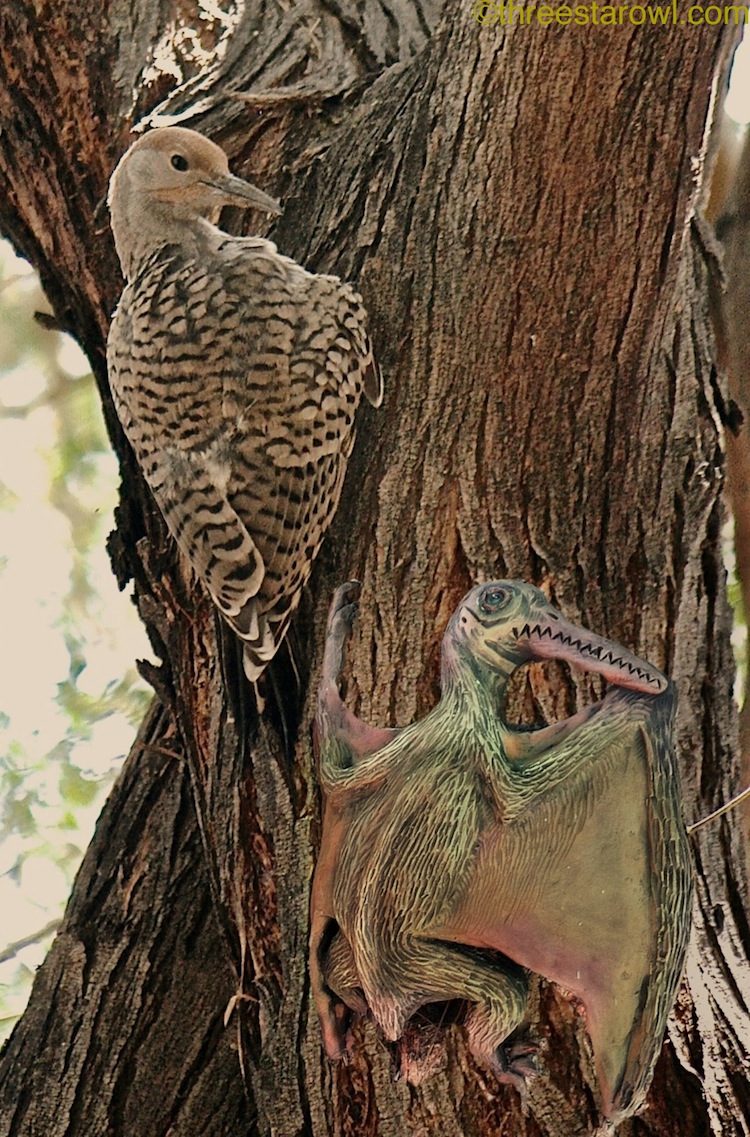
(Composite photo of young Gilded Flicker and a whimsical, biologically unsound Three Star Owl clay pterosaur effigy, by A.Shock)
Some birds really do not want to be seen, like certain mothy-plumaged nocturnals . With their barred and mottled markings, owls and nightjars can blend in day or night with any old thing: bark, stump, or rock. Owls are inclined to hide by perching upright against a trunk — Vertical Napping Bark — while nightjars (nighthawks, whip-poor-wills, and their relatives) often lie flush along a branch — Horizontal Napping Bark.
. With their barred and mottled markings, owls and nightjars can blend in day or night with any old thing: bark, stump, or rock. Owls are inclined to hide by perching upright against a trunk — Vertical Napping Bark — while nightjars (nighthawks, whip-poor-wills, and their relatives) often lie flush along a branch — Horizontal Napping Bark.
Below is some prime Horizontal Napping Bark for you, a Lesser Nighthawk E and I flushed off a desert trail early one morning while hiking. As we approached unknowing, it flew a scant dozen meters away and settled motionless in the middle of a mesquite tangle. We’d seen it land, otherwise we’d never have known it was there. Go ahead, Spot the Bird! Click on the image to enlarge it — it’s still hard to spot.
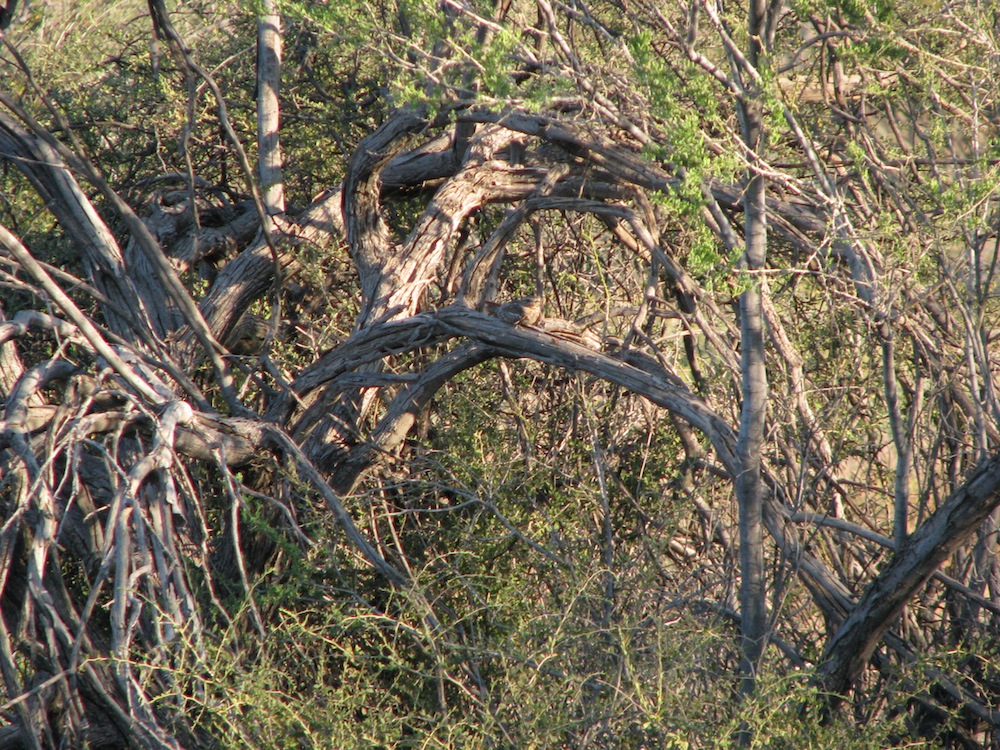
Lesser Nighthawks (Chordeiles acutipennis) are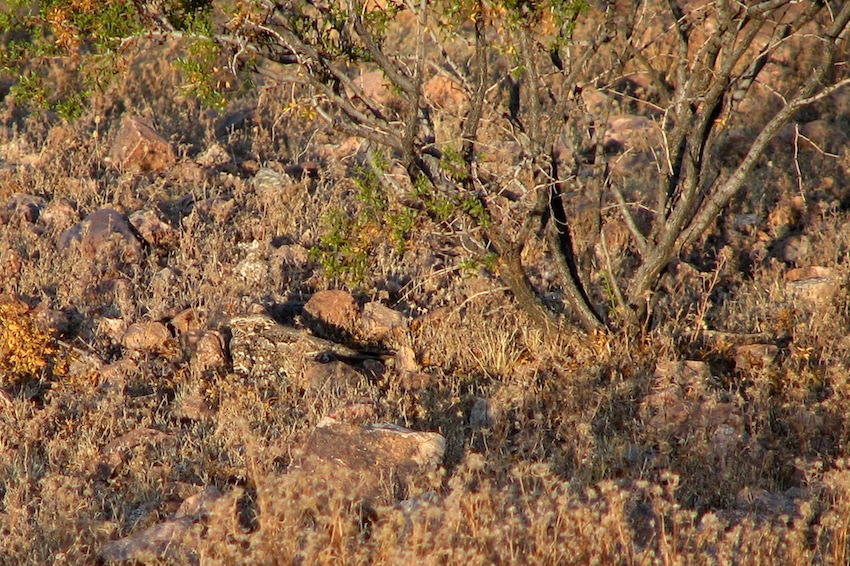 so confident in their camo that they nest out in the open, on rocky desert ground. Here’s one >> trusting to her mottliness to keep from being discovered incubating two eggs in Papago Park. Nesting sites must be chosen carefully to minimize the risk of being accidentally stepped on. Like other camo-reliant ground-nesters such as Killdeer, a Lesser Nighthawk mama will sit tight until the last minute of interloper’s approach (“crouch concealment”), than launch into a wing-fluttering display (“distress simulation”) to distract and draw away the looming threat. If distraction isn’t possible, they will become threatening, by puffing up and gaping their large pink mouths while hissing like a snake.
so confident in their camo that they nest out in the open, on rocky desert ground. Here’s one >> trusting to her mottliness to keep from being discovered incubating two eggs in Papago Park. Nesting sites must be chosen carefully to minimize the risk of being accidentally stepped on. Like other camo-reliant ground-nesters such as Killdeer, a Lesser Nighthawk mama will sit tight until the last minute of interloper’s approach (“crouch concealment”), than launch into a wing-fluttering display (“distress simulation”) to distract and draw away the looming threat. If distraction isn’t possible, they will become threatening, by puffing up and gaping their large pink mouths while hissing like a snake.
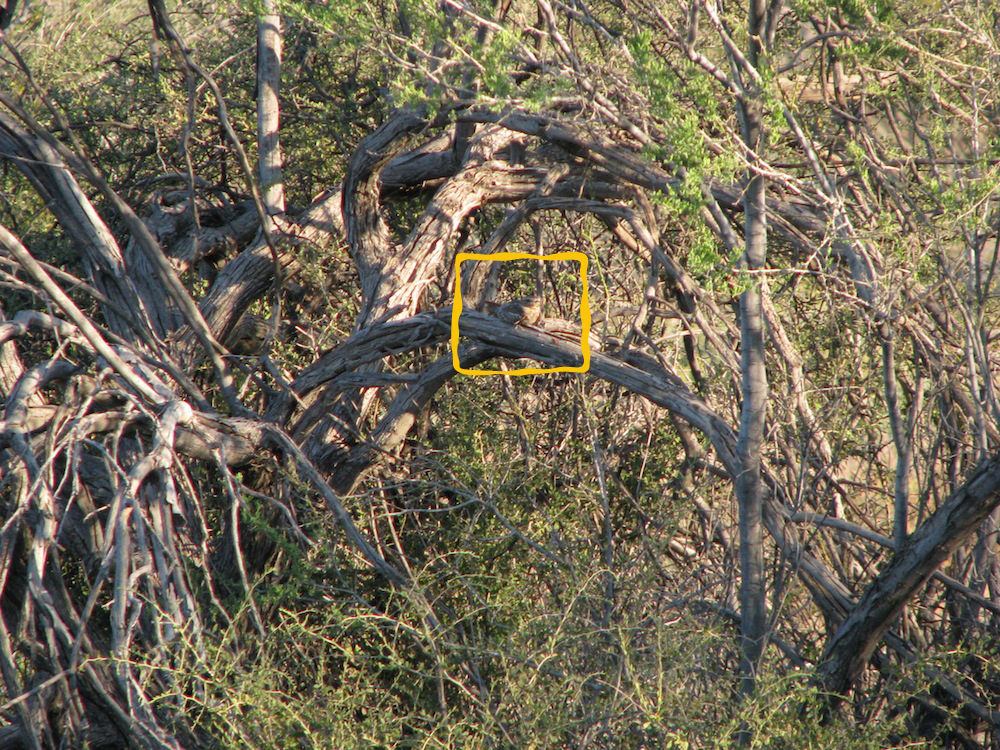 If you need a bit of help finding the Horizontal Napping Bark/Kipping Cobble in the photos, here are the keys, with the birds inside the wavery yellow boxes.
If you need a bit of help finding the Horizontal Napping Bark/Kipping Cobble in the photos, here are the keys, with the birds inside the wavery yellow boxes.
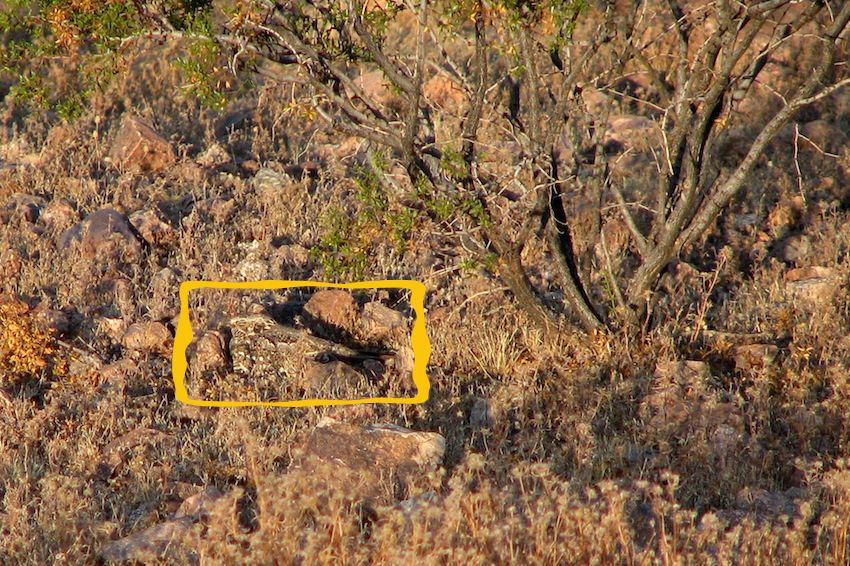
They’re both large files, so click to enlarge (both photos A.Shock).
And, watch your step!
I heard a sharp “pik” in the backyard this morning, so I grabbed the long lens and went out to look for the male Black-headed Grosbeak I’d heard and briefly glimpsed at dawn from the comfort of bed (birdwatching from bed is one of the things I love about the big sliding door in our bedroom — I should keep a bed-list: Harris’s hawk, Cooper’s hawk, three species of hummers, two owls heard, Gray fox, raccoons, etc, etc. Really, it’d be a pretty good list for mattress-based observation). Unfortunately, later in the day, no Grosbeak could be found.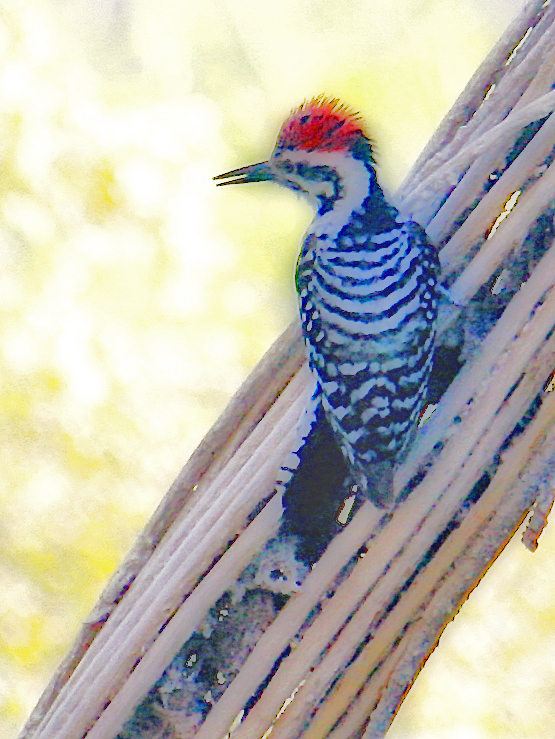
Instead, the generator of the “pik” call was a male Ladder-backed Woodpecker (Picoides scalaris) being shown the door by a Gila Woodpecker. Because the squabble was moving swiftly west across the yard, I managed only two or three shots and none of them were great.
The subject birds were in the shade with a brightly lit background, and because of the action, low light, and distance nothing was terribly sharp. But the Ladderback had perched fetchingly on a saguaro skeleton, and I decided to try to salvage the shot.
The result is above, a manipulated photo-based digital image, “overedited” for sure but pleasing nevertheless, with a painterly quality that captures the gist of the little woodpecker and his eponymous barred back. Not to mention his hilarious spiky red chapeau!
Below is the undistinguished original image for comparison, with the Gila Woodpecker off to the left:
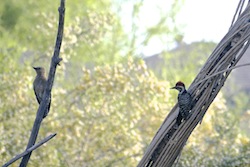
The process was hit or miss, and I don’t recall each step. But I started by cropping the shot heavily, then I ran it through a few filters (including the canned Orton filter effect) and stopped tweaking when I liked the look.
(Photos A.Shock)
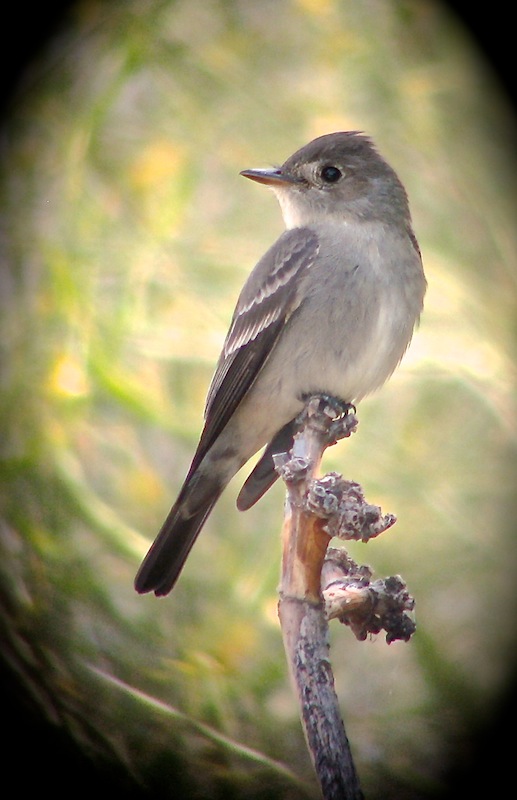 Updated and corrected 6 pm
Updated and corrected 6 pm
Apparently, it’s spelled Wood-Pewee. And, no, it’s not that the American Ornithological* Union has changed its mind (although that’s been known to happen) — it’s that after decades of birding, I just learned how to spell “Pewee”. All this time I thought it was “Peewee”.
That’s a good thing about birding: refresh, reset, renew.
Even if it’s only orthographic renewal.
>> right, Migrating Western Wood-Pewee (Contopus sordidulus). Below: same bird with a bee for lunch. (Photos A.Shock, digiscoped with a 65mm Zeiss spotting scope and my ancient Canon G7 point-and-shoot)
And speaking of needing refreshment, this little guy (or gal) has come from his winter home in Ecuador (or elsewhere in northern or western South America) to rest in our yard for a day, and to tank up on flying insect fuel. He’s on his way to his woodland breeding grounds north and uphill from here, and he could be almost there if he’s headed to Arizona’s Mogollon Rim. Or he could still have a long way to go, if his destination is inland Alaska. I asked him where he was going, but he was too polite to answer with a beakful of bugs.
All the way from South America! I think we can spare him a bee or two.
*Oh, and by the way, it’s “American Ornithologists‘ Union”, not “Ornithological“. Apparently, spelling pewee isn’t the only new thing I learned today.
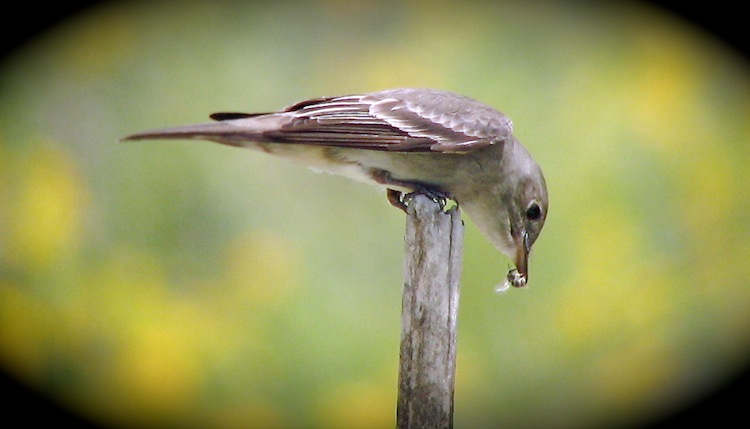
There are places like this in the garden and around the house:
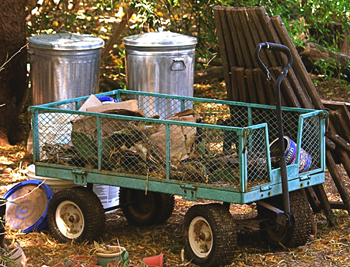
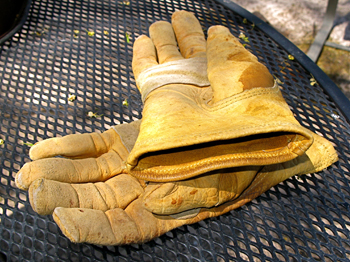
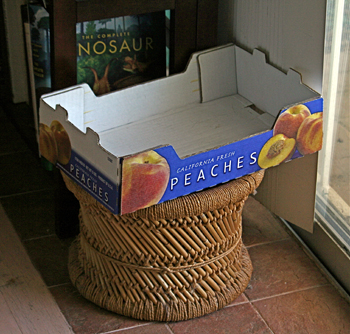
Laissez faire places, where neglected green wagons fill with garden miscellany, well-worn gloves are left out in the dust, empty peach flats perch forlornly on footstools. These neglected corners are golden places — especially in spring, when things are looking for private spots to nest. The three opportunities above were discovered by hens of one sort or another, females looking for somewhere to hole up with their young, to tuck in their larvæ, to get uninterrupted rest.
<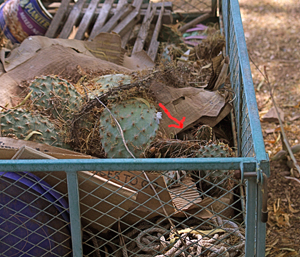 < Nid the First. The small red arrow points to where a Gambel’s quail hen has been sitting tight in the debris in our garden wagon for a few days. She’s easier to spot in the photo below, a tight telephoto of her wary eye from the same angle. I wish her luck: although she’s well-hidden from bumbling humans, we’re not sure how the youngsters will find their way over the sides of the wagon once they hatch. We have a policy of non-interference in these circumstances, but at some point, a ramp may have to be constructed. Update: while the hen was away briefly, it was possible to count 9 eggs in place.
< Nid the First. The small red arrow points to where a Gambel’s quail hen has been sitting tight in the debris in our garden wagon for a few days. She’s easier to spot in the photo below, a tight telephoto of her wary eye from the same angle. I wish her luck: although she’s well-hidden from bumbling humans, we’re not sure how the youngsters will find their way over the sides of the wagon once they hatch. We have a policy of non-interference in these circumstances, but at some point, a ramp may have to be constructed. Update: while the hen was away briefly, it was possible to count 9 eggs in place.
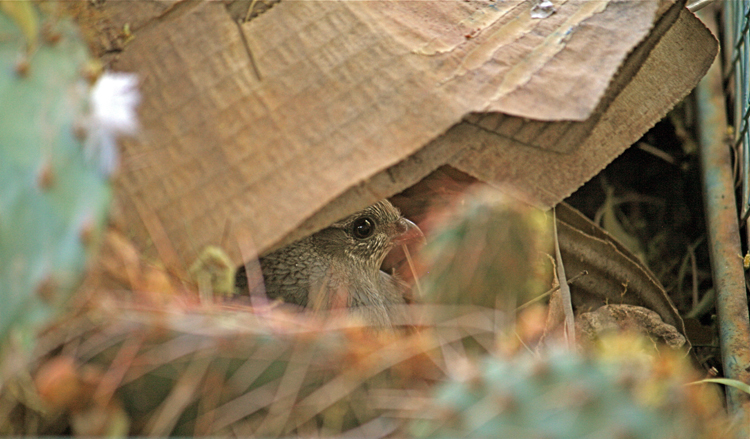
Nid the Second. In the desert, it’s advisable to always look into a shoe before slipping your foot in. The same goes for gloves left outside for a week: E tried to put on a work glove this morning, and found that his fingers didn’t go all the way in. Looking inside, he discovered that a female leaf-cutter bee had found the interiors of the stiff leather fingers just right for stashing her eggs (along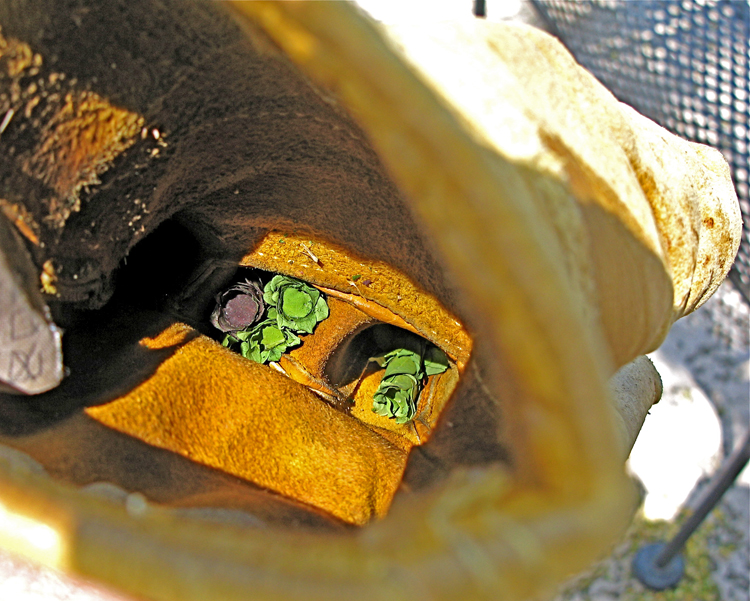 with food for the eventual larvæ) between individually-constructed layers of soft leaves — three green tubes and one purple. The colors of the tubes depend on the bee’s plant selection. A spare pair of gloves in the garage that no one was using enabled E to get the yardwork done, and the nest-glove and its contents were left to hatch or be scavenged.
with food for the eventual larvæ) between individually-constructed layers of soft leaves — three green tubes and one purple. The colors of the tubes depend on the bee’s plant selection. A spare pair of gloves in the garage that no one was using enabled E to get the yardwork done, and the nest-glove and its contents were left to hatch or be scavenged.
Nid the Third. The final nesting location is more domestic, and will not be news to anyone with cats: it’s the simple miracle of a box spontaneously generating a cat of 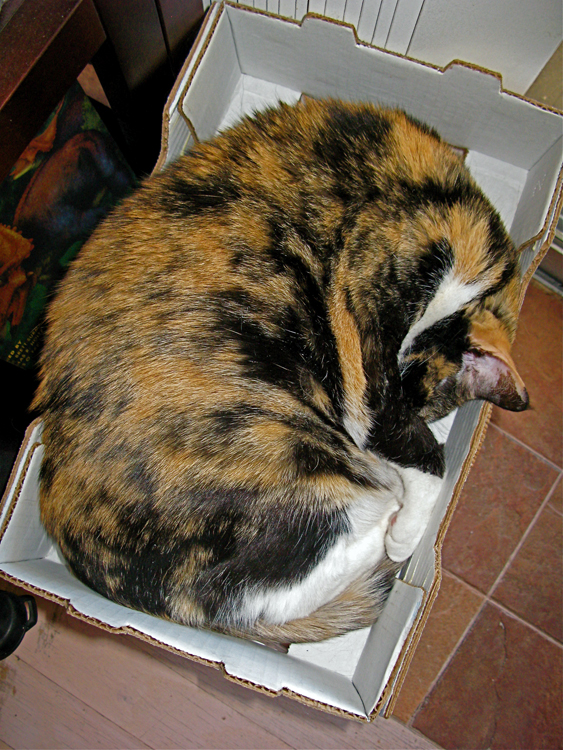 precisely equivalent volume. Here Miss B has condensed in the peach-flat we call the “Summer Palace” since it sits by the sliding glass door, allowing the sights and smells of the back yard to be taken in at leisure, even in sleep.
precisely equivalent volume. Here Miss B has condensed in the peach-flat we call the “Summer Palace” since it sits by the sliding glass door, allowing the sights and smells of the back yard to be taken in at leisure, even in sleep.
With all of these casual nesting choices being made in objects intended for another purpose, I’d like to point out the irony of the fact that the deliberate, pricey nest box we set up for woodpeckers and/or screech owl is unused, so far. Of course: it’s the wildlife correlation to kids ignoring the toy, but playing with the box it came in.
(All photos by A.Shock)






















